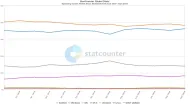5 Trends Shaping the Future of RPA For 2024 & Beyond


Investment in RPA has grown exponentially in the last couple of years. And so has its use case: RPA is now being used in various sectors, such as education, automotive, sales, retail, and more.
However, challenges remain:
- Lack of process intelligence leads to long pilot periods where unforeseen issues surface regularly
- Citizen-led development is growing slower than expected. Programming bots require coding and therefore RPA programmers are needed in most cases.
- RPA bots are still used to automate simple, repetitive processes. AI-driven hyper-automation still seems years away in most processes.
How is the RPA ecosystem dealing with these issues? In this article, we cover new technological advances and collaborations aiming to overcome these issues.
1. Facilitated development with no code RPA
Simplifying RPA programming will help democratize RPA and expand its use cases. Currently, most RPA automation is achieved through programming which is one of the major costs of RPA implementation.
This is a limiting factor, as RPA developers are required for RPA development. Unless you know the latest no-code RPA solutions, you could get stuck with a long programming period and heavy reliance on 3rd parties.
Anyone who dabbled in coding knows that it’s a difficult process. It’s complex and requires a methodical way of thinking, which most people are not professionally trained for. That’s why leading VCs view the trend of making programming easier, low code/no code, as one of the biggest trends in enterprise software with already big success stories like Twilio and Airtable.
RPA is no different. Once the process is clear, it needs to be programmed. Though RPA programming is easier than more complex programming like back-end programming or full-stack programming, it still requires an effort to learn. There are numerous RPA training courses launched both by RPA companies and others. This is also why RPA companies rely on partners such as consultancies and system integrators (SIs). While RPA consultants and SIs supply and charge for the programming time, RPA companies provide the software licenses.
This is changing. Startups are launching no-code solutions while RPA companies try to simplify programming. To understand no-code RPA better, we created a comprehensive guide on no-code RPA and reviewed top no-code RPA solution providers. Democratizing RPA can be as powerful as the launch of excel which empowered and changed the finance community forever. Given RPA’s broad field of application, no code RPA has the potential to revolutionize white-collar work.
2. Leverage process mining to auto-extract process knowledge for RPA
Even before programming, RPA developers need to understand the process they are programming. However, accessible process information is lacking in most companies. Auto-extracting process knowledge from videos and logs is one of the top priorities for RPA companies.
Unless you work for a governmental agency, even the most repetitive processes rarely have manuals or up-to-date diagrams. Companies; however, are trying to build such process diagrams. Companies such as Software AG have achieved multi-billion valuations with tools like ARIS process modeler. However, it’s generally rare to see exhaustive and up-to-date process catalogs, because it takes so much effort to keep those catalogs up-to-date. So companies just decide that it’s more efficient not to have them.
The current solution is to run interviews to gain a high-level understanding of the process, cross-check logs for outliers and run extensive pilots to ensure that process has been modeled correctly. This is a manual and time-consuming process.
Both startups and large RPA companies are working to solve this problem. Using videos of users running a process along with system logs is an exciting area of RPA research. Though we have read about vendors discussing this technology, we have not yet heard large-scale success stories from customers yet.
Another approach is to leverage system logs. Process mining involves an auto analyzing system to extract process flows and generate insights about processes. Process mining has numerous use cases but it can also support RPA development. Process mining companies and process mining modules developed by RPA companies help understand process flows, facilitating RPA development.
3. Enable bots to have a larger set of capabilities with RPA marketplaces
RPA marketplaces enable RPA bots to have a larger set of capabilities, allowing companies to automate processes more easily. This is because no single provider can provide all the functionality to automate the diverse number of processes in use at companies. Marketplaces allowed operating systems (e.g. Apple App Store), CRM software (Salesforce AppExchange), and numerous other platforms to extend their reach. Read our articles on RPA marketplaces and reusable RPA plugins to learn more.
A common example where marketplaces are helpful in automating document-based processes. Most RPA developers rely on simple OCR tools built into RPA systems and rule-based programming to extract data out of documents. Machine learning-based document extraction tools can make automating document-based tasks both easier and more accurate. The most common document-based process is invoice processing, feel free to read our articles on invoice capture and processing.
A new approach to RPA marketplaces is to enable developers of popular software to easily submit their code into RPA deployments.
If you are a developer, you can read our guide for Python developers to take advantage of the growth of RPA via marketplaces or via developing RPA solutions.
4. Expand the scope of processes to automate with cognitive automation
While the previous 2 areas make RPA easier and faster to deploy, cognitive automation enables RPA to leverage AI and machine learning to expand the scope of processes it can automate, such as:
- Integrating RPA solutions with chatbots to create an end-to-end automated experience for users in healthcare, customer service, or IT.
- Leveraging OCR and NLP to tackle handwritten documents, such as KYC documentation, financial transactions, and insurance policies.
See our comprehensive article on cognitive automation here.
5. Implement a more transparent RPA with open source
RPA is becoming more widespread and widespread technology categories tend to have open-source offerings.
While there were a handful of RPA vendors just a few years ago, RPA is now offered by almost a hundred companies as of 2023. It is becoming less costly to build a competitive RPA solution.
The demand for open-source RPA software is expected to increase. With all things being equal, enterprises favor open source solutions since they offer more transparency and can be lower cost as enterprises only need to pay for services.
These developments favor open-source RPA. And we are seeing growth in the open-source RPA ecosystem with new companies being launched. We expect more for-profit companies to monetize open source RPA products and help expand the market.
For more on RPA
More curious about the current state of RPA? Feel free to dive into our RPA articles such as our comprehensive guide on RPA or our guide on RPA vendors and tools.
If you want to gain a comprehensive overview of RPA, we also have a whitepaper on the topic:
If you are looking for an automation solution to transform your business, scroll through our data-driven lists of RPA tools and automation solutions.
And feel free to reach out to us for guidance through the process:

Cem has been the principal analyst at AIMultiple since 2017. AIMultiple informs hundreds of thousands of businesses (as per similarWeb) including 60% of Fortune 500 every month.
Cem's work has been cited by leading global publications including Business Insider, Forbes, Washington Post, global firms like Deloitte, HPE, NGOs like World Economic Forum and supranational organizations like European Commission. You can see more reputable companies and media that referenced AIMultiple.
Throughout his career, Cem served as a tech consultant, tech buyer and tech entrepreneur. He advised businesses on their enterprise software, automation, cloud, AI / ML and other technology related decisions at McKinsey & Company and Altman Solon for more than a decade. He also published a McKinsey report on digitalization.
He led technology strategy and procurement of a telco while reporting to the CEO. He has also led commercial growth of deep tech company Hypatos that reached a 7 digit annual recurring revenue and a 9 digit valuation from 0 within 2 years. Cem's work in Hypatos was covered by leading technology publications like TechCrunch and Business Insider.
Cem regularly speaks at international technology conferences. He graduated from Bogazici University as a computer engineer and holds an MBA from Columbia Business School.
To stay up-to-date on B2B tech & accelerate your enterprise:
Follow onNext to Read
Semantic Automation in 2024: The Future of Process Automation
50 RPA Statistics from Surveys: Market, Adoption & Future [2024]
What is Intelligent Automation: Guide to RPA's Future in 2024
Nice article. RPA future is bright only by expanding its features.
Good to know this. The world is running with RPA. this article is very useful. keep posting articles like this that are effective and useful.


Comments
Your email address will not be published. All fields are required.